The Great Depression introduced a new market for luxury on a budget. There were many different types of beautiful glass pieces produced during those hard years, but they have some key differences.
Depression glass is clear, colored glass that was produced during the Great Depression as a more affordable replacement for crystal and china dishes. Carnival glass and uranium glass were both produced in the same era, but carnival glass has an iridescent finish and uranium glass glows green.
Diving into the nuances between the different glass pieces from the Depression Era provides insight into the time period and will elevate your understanding as a collector or appreciator.

What Is Depression Glass?
When the Great Depression hit, the population of people who could afford luxuries like crystal and porcelain was severely diminished. Manufacturers were suddenly faced with the dilemma of nobody buying their products anymore. Those factories wanted to stay in business and employ as many people as possible through such a difficult time, so they had to adjust their inventory.
Although times were tough and it was a struggle to make ends meet, people still sought after the feel of luxury. Now more than ever, people were striving for some sort of normalcy. They couldn’t buy the crystal that they might have wanted to, but they could buy imitation glass.
The production of pressed glassware was much faster and cheaper than crystal or porcelain. It could be produced in a variety of translucent colors, or be left clear and “crystal”. Producing depression glass pieces saved a lot of manufacturing business as they were able to improve efficiency, reduce costs, and increase sales.
The rest of the population fueled these sales because they were able to get a taste of the finer things in life without the high price tag. Depression glass filled the homes of honest, hardworking people who were looking for ways to maintain a sense of normalcy and celebration despite the changing circumstances.

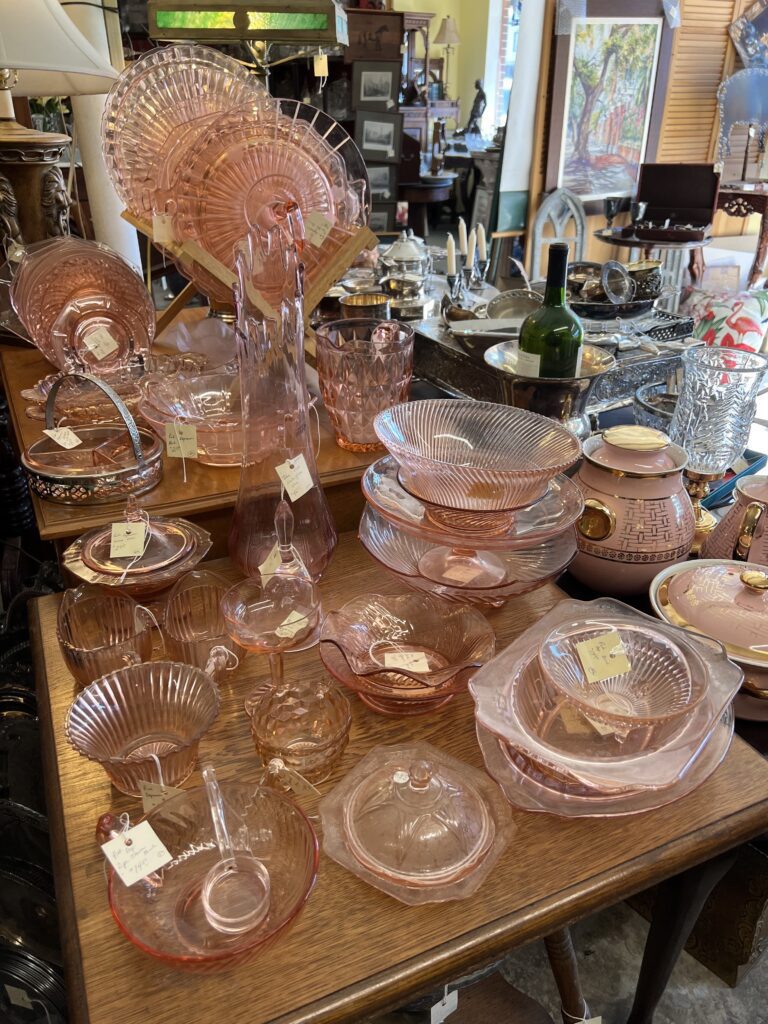
These pieces were sold for around 25 cents or were given away as a part of promotions. Full sets often were given away with the purchase of large appliances like a fridge, and individual pieces were given away to customers buying necessities like gas or groceries.
Since the production was so cheap, many businesses used glassware as a way to sweeten deals and win customers. Of course, people could also purchase straight from the manufacturer to get a matching set or a specific piece they wanted.
Depression glass was produced in a variety of different colors and patterns. Different additives could change the glass from clear to pink, green, amber, or white. Candlesticks, plates, serving dishes, ashtrays, and more items are made out of depression glass. (Source)
Although the coloring additives and mass production often resulted in small flaws throughout the pieces, depression glass is still considered a popular collectible item. The pieces that were produced in the 1920s-40s can be quite valuable.
However, for people that love the look of colored glass but do not care about the historical significance, depression-style glass is produced today. You can even buy depression-style pieces on Amazon. Recently produced “depression glass” is not actually depression glass, but to an untrained eye, it will look the same.
What Is Carnival Glass?
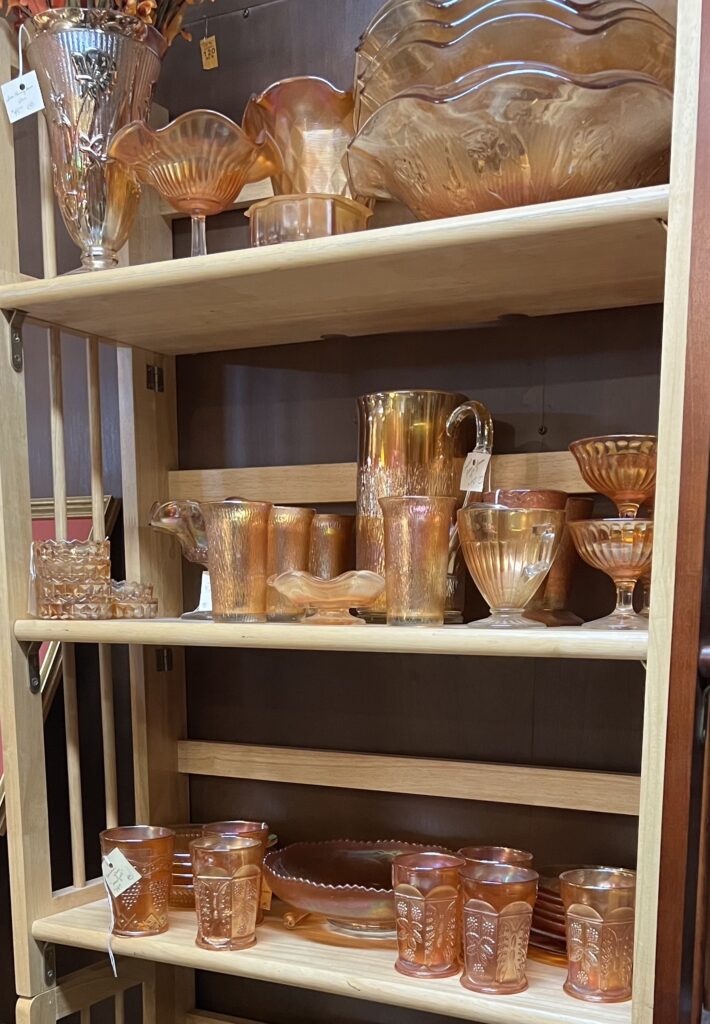
Carnival glass gets its name from both its appearance and its history. Carnival glass was most popular during the 1920s, right before the Great Depression. During this time, a company called Tiffany and Steuben was producing blown glass art with an iridescent finish.
These pieces were quite popular because of their beauty but were more expensive than the middle class could afford. Carnival glass was produced by the Fenton Glass Art Company as an imitation of Tiffany glass. Fenton pressed the glass rather than blowing it, which allowed for mass production and much lower expenses.
Fenton was not able to sell this pressed imitation glass for as much as Tiffany sold their pieces, but when Fenton brought the prices down, it quickly became a middle-class favorite. After marking down prices, Fenton was able to further increase popularity through fairs and carnivals.
The pressed iridescent glass was used as prizes for various carnival events. The glass’s prevalence at carnivals and fairs introduced the name of “carnival glass”, which is further solidified by the colorful appearance.
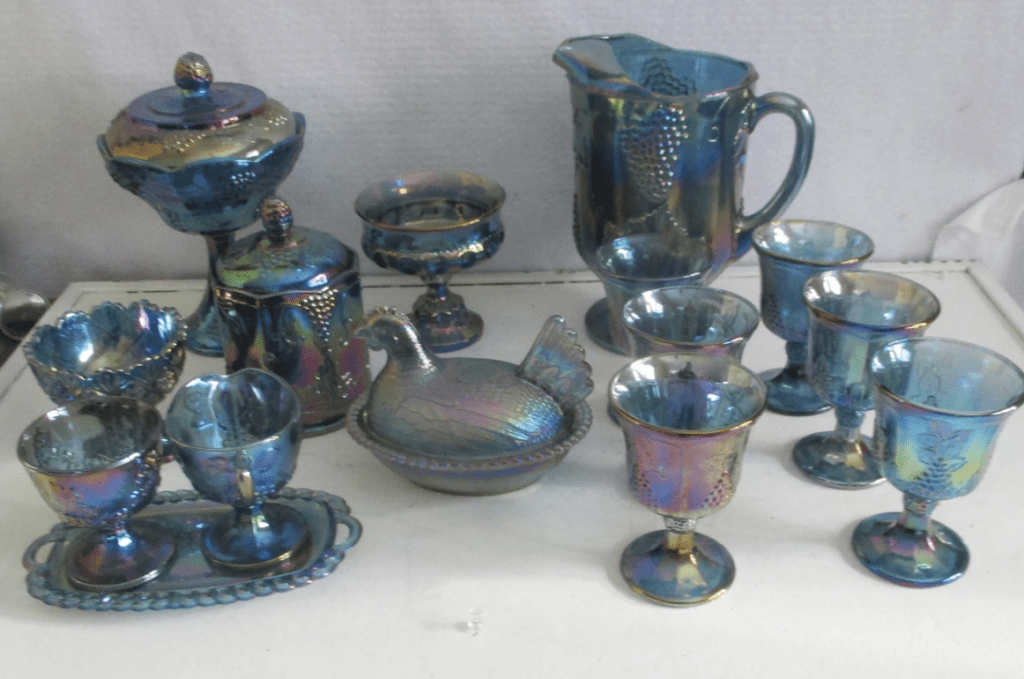
You can tell carnival glass apart from any other glassware because it has an unmistakable iridescent shine. The color-changing rainbow finish that mimics the look of oil on water is caused by the application of metallic salts after the glass has been pressed. Right after pressing, while the glass is still hot, the salts are sprayed onto the surface of the glass. The glass is then fired a second time to make the coating permanent.
Although depression glass was pressed in a similar way, the salts were not used, so depression glass doesn’t have the same sheen as carnival glass.
The iridescence could be applied to all sorts of colors of glass. Most commonly, a clear glass base was used and the metallic salts would grate a golden yellow oil slick color. Salts were also applied to white glass for an opal look or darker colors like purple, blue, and brown. (Source)
What Is the Difference Between Carnival Glass and Depression Glass?
Carnival glass and depression class were produced during a similar time period for a similar demographic of customers. They are both mass-produced, pressed glass, imitations of a more expensive product. Carnival class imitated Tiffany glass, and depression glass imitated crystal glass. This made them very popular among the working class.
Similar types of products were produced from both of these types of glass. Housewares such as vases, tablewares, and centerpieces were produced out of both carnival glass and depression glass. Both carnival and depression glass are produced by pressing molten glass into molds.
There is a small difference in the time frame for the production of these two types of glass. Carnival glass reached its peak popularity a decade or so before depression glass did. The peak of popularity for carnival glass was right before the Great Depression Era, but this finish of glass was being produced a decade earlier. It was called “iridill” back then.
Carnival glass also came back into production in the early 2000s, but the vast majority of pieces were produced sometime before the Great Depression started.
The biggest and most obvious difference between carnival glass and depression glass is in appearance. Depression class is always monochrome and typically translucent. It comes in a variety of colors, but it is see-through and has only one consistent color. Carnival glass all has a special finish from the metallic salts. If the glass was not retired with the salt finish, it is not carnival glass.
Spraying a hot piece of pressed glass with a special formula of metal salts, then refiring the piece, produces a unique look that depression glass will never have. Carnival class can also come in a variety of colors, but any color will have an “oil-slick” appearance that covers the piece in changing rainbow colors as you hold it to the light. (Source)
What Is Uranium Glass?
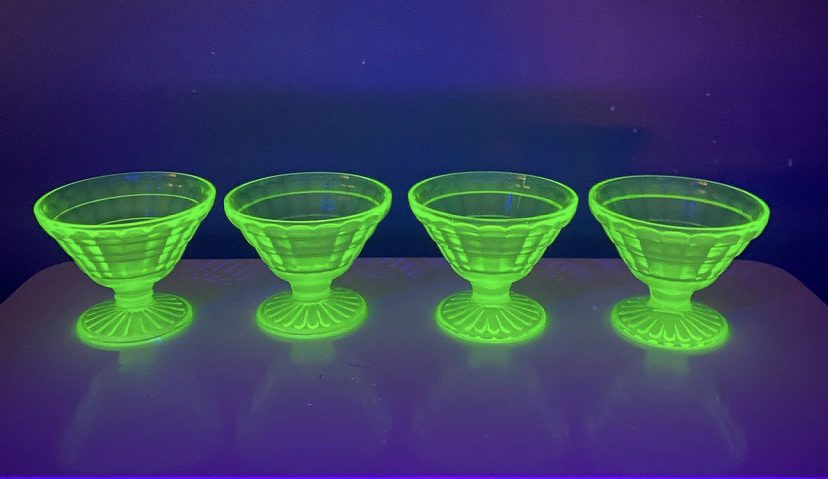
Uranium glass, as the name suggests, contains uranium as an additive. In the molten stage, a uranium compound is added to the glass, which turns the piece a translucent yellow-green color. Any glass that is colored with uranium (within a certain percentage) is considered to be uranium glass.
At different points in production history, additional additives have been included with the uranium compound to produce a darker shade of green. This is still considered uranium glass. However, if uranium is the only additive, then that uranium glass may also be called vaseline glass. Purely uranium-colored glass is called vaseline glass because the green-tinged yellow color is similar to the clear-yellow color of petroleum jelly.
Uranium adds color to the glass, but that’s not all it does. When placed under a black light, uranium glass will produce a green glow. Uranium is a radioactive element, although it is not dangerous in the quantities used in glassware. The radioactive properties cause the glass to glow when under a blacklight. This can be a helpful way to determine if a glass piece contains any uranium.
Uranium glass has a long history of production. Uranium was first used as a glass colorant in the 1830s. It peaked in popularity in the early 1900s around the same time as carnival glass and depression glass. During World War II, the government took control of uranium supplies, and production was temporarily stalled. After the war, production resumed, but uranium glass was never quite as popular again as it was before the war. (Source)
What is the Difference Between Uranium/Vaseline Glass and Depression Glass?
Some depression glass is green, and uranium glass was produced during the depression era, so what’s the difference? Not all uranium glass is depression glass, and not all depression glass is uranium glass, but there is some overlap.
During the depression glass era, green was a very popular color, and uranium was typically the way that the green color was achieved. To get a darker green color, rather than the typical yellow-green from uranium, iron oxide was also added to the molten glass. This glass would be considered uranium glass, but could not be called vaseline glass since there are extra additives besides the uranium.

Although there is some overlap, depression glass and uranium glass are not interchangeable. Depression glass is limited to a much smaller window of production. True depression glass was only produced during a small window of about 20 years, centered on the Great Depression. Being produced during this time period is part of what defines a piece as depression glass.
Uranium glass is not limited to such a specific era. The defining feature of uranium glass is the use of uranium to produce a yellow-green color and a fluorescent glow. The production of uranium glass goes back almost two centuries. Uranium glass can be modernly produced, while depression glass can only have modern imitations.
Uranium glass is much more restrictive than depression class in color options. Both types of glass have translucent colors, but uranium glass must be somewhere in the green family. Different compounds can be added to the uranium and molten glass to create some color variance, but any significant amount of uranium will cause the glass to be in the yellow-green color family.
Uranium will also always cause the glass to glow green under black light, while depression glass often does not glow.
Depression glass can certainly be yellow or green, but it can also be blue, orange, pink, brown, or white. Both types of glass were used to make common housewares and decorations. (Source)
Is all Green Depression Glass Uranium Glass?
Some but not all green depression glass is uranium glass. Other chemical and elemental compounds can be used as colorants to produce green glass, but during the depression era, uranium would have been the dominant colorant of choice. Since a lot of green glass produced during the depression era has uranium, it is considered uranium glass. (Source)
To determine if a piece of green depression glass is also uranium glass, you can use a black light. Not all depression glass will glow. Looking at the glassware under black light will reveal a fluorescent green glow if the piece is uranium glass. This is an easy, quick, inexpensive, and accurate way to identify the presence of uranium glass.
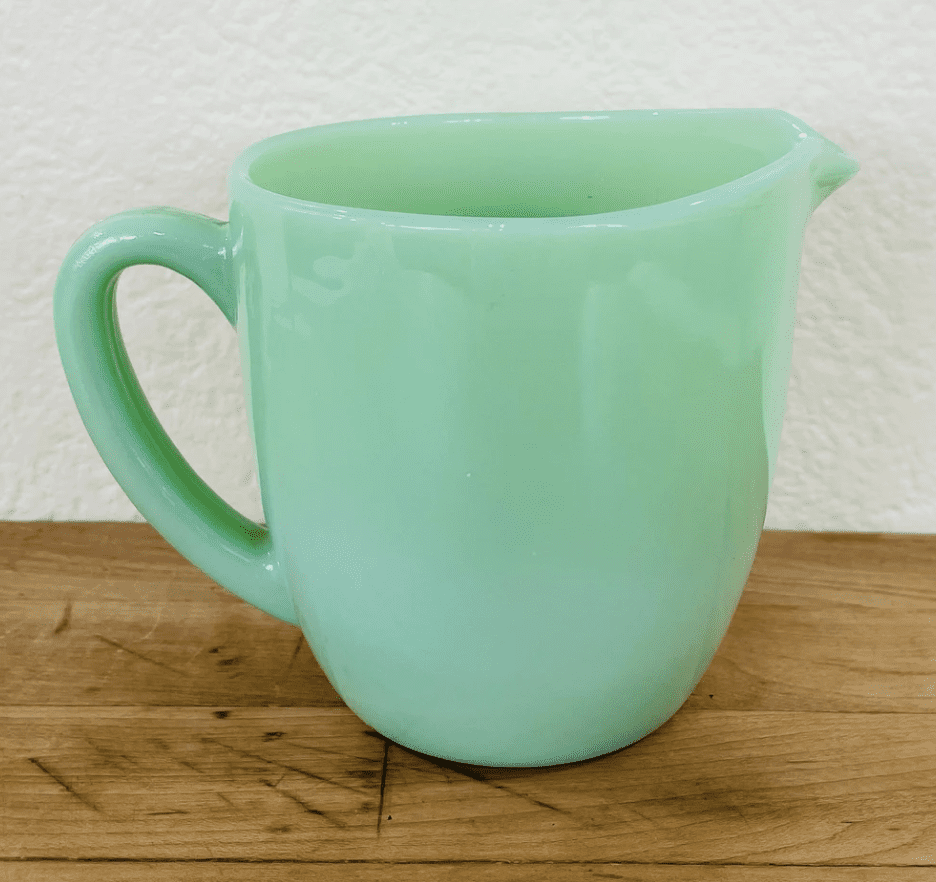
Although green depression glass is likely uranium glass, it is not vaseline glass. To get the green color instead of a more washed out yellow-green depression glass uses an additional compound, usually iron oxide. The iron oxide, or rust, darkens the color to a more solid green. Vaseline glass only uses uranium as a dye, so green depression glass would not be considered vaseline glass.
However, vaseline glass that was produced during the Great Depression is not also depression glass. Depression glass comes in a variety of colors, vaseline glass does not. These two categories can overlap when uranium is the only additive and the production took place sometime around the Great Depression.

